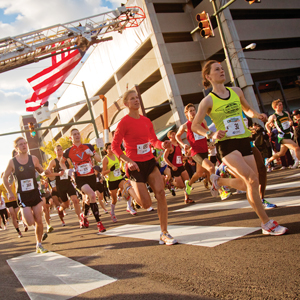Doesn’t everyone know someone who took part in the Ukrop’s Monument Avenue 10K last month? For many of us, walking Richmond’s celebrated route was a good option. There’s a mile event for kids, too, so even the youngest members of the family can take to the streets to welcome spring and promote health and wellness.And of course, thousands lined the city course to cheer on the participants.
Whether you are an experienced runner, walker, or a rookie, proper training is important. Poor training can result in foot pain and put a hitch in your step, or worse, stop you in your tracks altogether.
“Your foot is a complex structure,” says Tim Zimmer, MD, an orthopedist at Commonwealth Orthopedic Specialist, Inc., who specializes in foot and ankle issues.“There are many moving parts, and injury to any one of them can result in pain that can bring an abrupt halt to your running.”
Your foot is composed of an astonishing 27 bones, 33 joints, 112 ligaments, and 19 tendons. Each of these is supplied by blood vessels and nerves. Foot pain can result from injury or fatigue in any one of these parts, cascading into generalized pain because their normal interactions are disrupted. Since the weight of your body is carried on each foot with every step – and multiplied when you are running – it’s easy to see why foot health is so important.
“You need to understand the basic anatomy of your feet,” Dr. Zimmer says. “It’s important to know what kind of arch you were born with – or perhaps acquired after an injury.” Feet with high arches (known as supinators or under-pronators), for example, don’t absorb the shock of the foot-strike very well, possibly resulting in pain in the outer side of the foot, lower leg, and knee. Flatter arches, or pronators, can transmit force to the inner sides of the shin, resulting in shin splints and other problems.
According to Dr. Zimmer, many of the injuries experienced by runners occur with no obvious history of trauma. If you run on hard surfaces, the stress on your feet and legs is increased; soft surfaces, like sand for instance, can disturb your gait by making your heel sink and causing your Achilles tendon to stretch. Constantly running uphill, downhill, or on a slanted road shoulder can also result in injury. Practicing poor technique in general and running while seriously overweight are also factors that might contribute to injury.
Foot pain in runners may be caused by Plantar fasciitis, stress fractures, tendinitis of one of the many tendons in the foot, inflammation of the sesamoid bones which act as little fulcrums for tendons, Morton’s neuroma, and hematoma under the toenail, among others. Ligaments can stretch or tear, and the Achilles tendon can be injured or even ruptured.
“As an athlete myself, I understand how we all want to get out there and pick up where we left off in the fall, but this isn’t the smart way to get ready for the new season,” Dr. Zimmer says, whose sport of choice is tennis. “You have to remember all of those moving parts, and follow a plan to make sure everything stays healthy.”
If you’re a fair-weather runner, you might be thinking that your last substantial run in late fall should be your starting point this spring. This attitude can lead to trouble.
Overtraining is the single biggest cause of foot pain in runners according to Dr. Zimmer, who says many runners try to abide by the 10 percent rule. “The best approach is to increase your mileage by about 10 percent per week, allowing at least one day to rest and recover between runs. Crosstraining with cycling or swimming will also help to get you into shape without hurting your feet.”
Next winter, keep in mind that training three to four times per week on alternate days is a good idea. This will help maintain your endurance and strength, especially if you have done some cross-training with weights and aerobic exercises. If you do run through the winter, exercise physiologists will tell you that it’s best to focus on maintenance, and not on increased mileage or speed, both potentially dangerous in cold or icy conditions.
Experts know that shoes are the most important equipment for a runner. Look for a shoe that matches your foot anatomy, running style, and the surface you prefer. If you are fl at-footed or your foot turns inward, you will need shoes with good stability and support. If you have high arches or your foot turns outward, look for increased cushioning and support.
Buying from an experienced salesperson who understands how to meet runners’ needs can be worth much more than the money you might spend on what looks like the latest technology. Also, watch your mileage. According to SportMedWeb, an educational website for endurance athletes, if you are a casual runner, you can get about 500 miles out of a good-quality shoe. Highintensity runners should consider getting new shoes every 350 miles. How much wear you get from your shoes will vary with your style, intensity, and surface, so consider rotating running shoes with similar shoes, or learning to detect signs of wear.
“Foot problems can usually be cured without surgery and with proper attention to training strategies,” Dr. Zimmer says. “But it’s important to get good medical care and treatment to prevent further injury if there is pain present.”
What’s the best course for the multitude of runners out there? According to Dr. Zimmer, it’s prevention of foot injury by making smart training decisions from mile one.





